1995 BUICK REGAL coolant level
[x] Cancel search: coolant levelPage 191 of 340
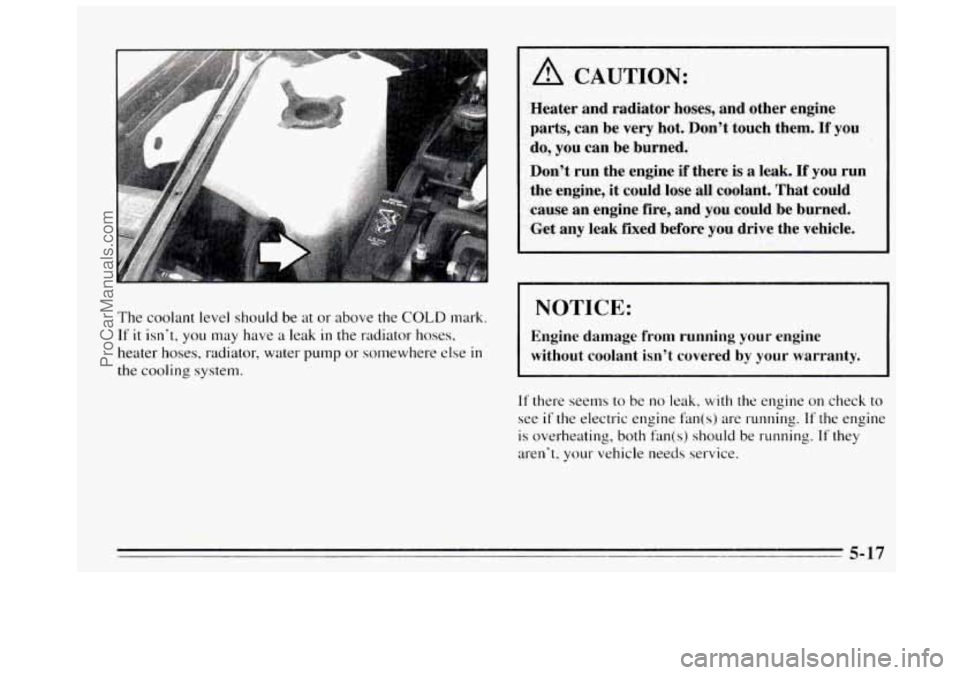
The coolant level should be at or above the COLD mark.
If it isn’t, you may have a leak in the radiator hoses,
heater hoses, radiator, water
pump or somewhere else in
the cooling system.
I A CAUTION:
Heater and radiator hoses, and other engine
parts, can be very hot. Don’t touch them.
If you
do,
you can be burned.
Don’t run the engine
i€ there is a leak. If you run
the engine, it could lose all coolant. That could
cause an engine fire, and you could be burned.
Get any leak fixed before you drive the vehicle.
NOTICE:
Engine damage from running your engine
without coolant isn’t covered
by your warranty.
If there seems to be no leak, with the engine on check to
see
if the electric engine fan(s) are running. If the engine
is overheating, both fan(s) should be running. If they
aren’t, your vehicle needs service.
ProCarManuals.com
Page 192 of 340
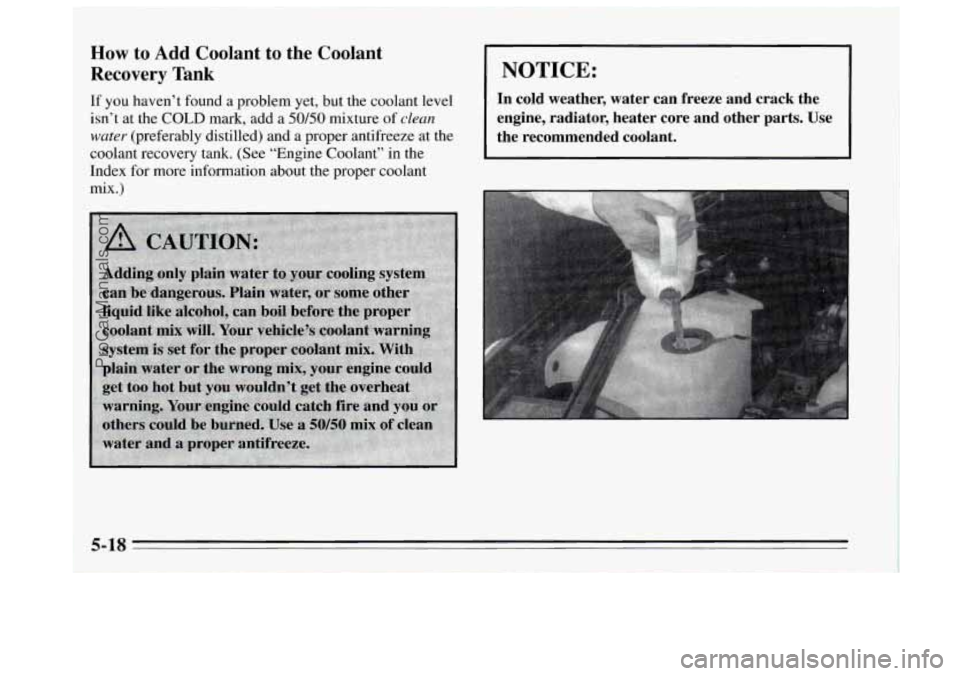
How to Add Coolant to the Coolant
Recovery Tank
If you haven’t found a problem yet, but the coolant level
isn’t at the
COLD mark, add a 50/50 mixture of clean
water (preferably distilled) and a proper antifreeze at the
coolant recovery tank. (See “Engine Coolant” in the
Index for more information about the proper coolant
mix.)
NOTICE:
In cold weather, water can freeze and crack the
engine, radiator, heater core and other parts. Use
the recommended coolant.
5-18
ProCarManuals.com
Page 197 of 340
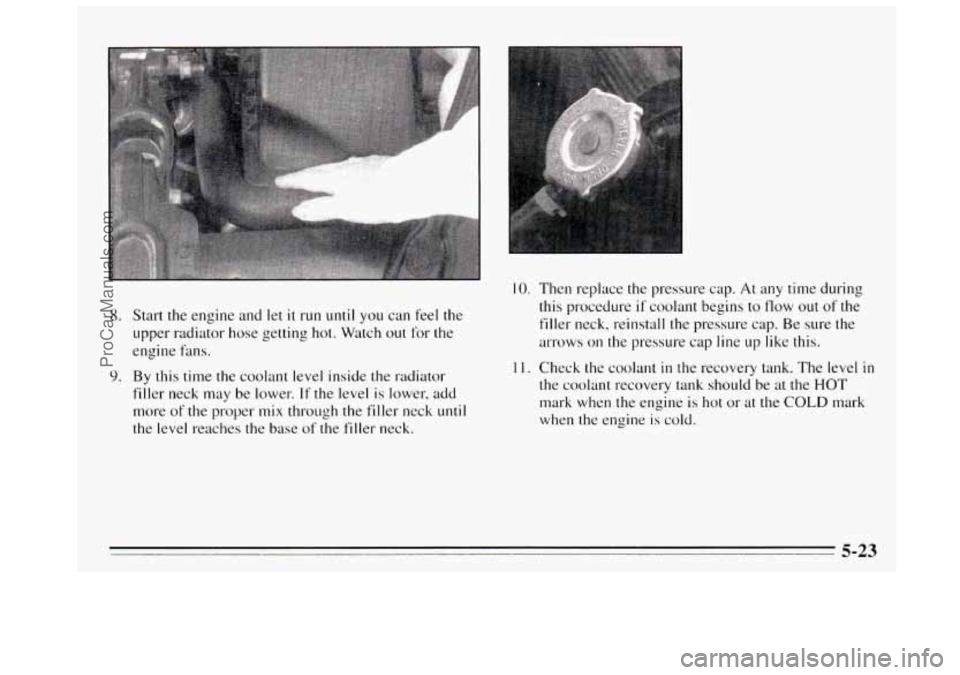
8. Start the engine and let it run until you can feel the
upper radiator hose getting hot. Watch
out for the
engine hns.
9. By this time the coolant level inside the radiator
filler neck may be lower.
If the level is lower, add
more
of the proper mix through the filler neck until
the level reaches the base of the filler neck.
10. Then replace the pressure cap. At any time during
this procedure
if coolant begins to flow out of the
filler neck, reinstall the pressure
cap. Be sure the
BI-~OWS on the pressure cap line up like this.
1 1 - Check the coolant in the recovery tank. The level in
the coolant recovery tank should be at the HOT
mark when the engine is hot or at the COLD mark
when the engine
is cold.
5-23
ProCarManuals.com
Page 225 of 340

How to Add Fluid
Refer to the Maintenance Schedule to determine what
kind of transaxle fluid to use. See “Recommended
Fluids and Lubricants”
in the Index.
If the fluid level is low, add only enough of the proper
fluid to bring the level into the cross-hatched area on the
dipstick.
1. Pull out the dipstick.
2. Using a long-neck funnel, add enough fluid at the
dipstick hole
to bring it to the proper level.
It doesn’t take much fluid, generally less than a pint
(OSL). Don ’t ouefill. We recommend you use only fluid
labeled DEXRON@-111, because fluid with that label is
made especially for your automatic transaxle. Damage
caused by fluid other than DEXRON@-I11 is not covered
by your new vehicle warranty.
After adding fluid, recheck the fluid level as
described under “How
to Check.”
When the correct fluid level is obtained, push the
dipstick back in all the way.
Engine Coolant
The following explains your cooling system and how to
add coolant when it is low. If you have a problem with
engine overheating or if
you need to add coolant to your
radiator, see “Engine Overheating” in the Index.
The proper coolant for your Buick will:
Give freezing protection down to -34°F (-37°C).
Give boiling protection up to 262 OF (1 28 O C).
Protect against rust and corrosion.
Help keep the proper engine temperature.
Let the warning lights work as they should.
What to Use
Use a mixture of one-half clean water (preferably
distilled) and one-half antifreeze that meets “GM
Specification
1825-M,” which won’t damage aluminum
parts. You can also use a recycled coolant conforming to
GM Specification 1825-M with a complete coolant flush
and refill. Use GM Engine Coolant Supplement (sealer)
with any complete coolant flush and refill.
If you use
this mixture, you don’t need to add anything else.
~
6-17
ProCarManuals.com
Page 226 of 340
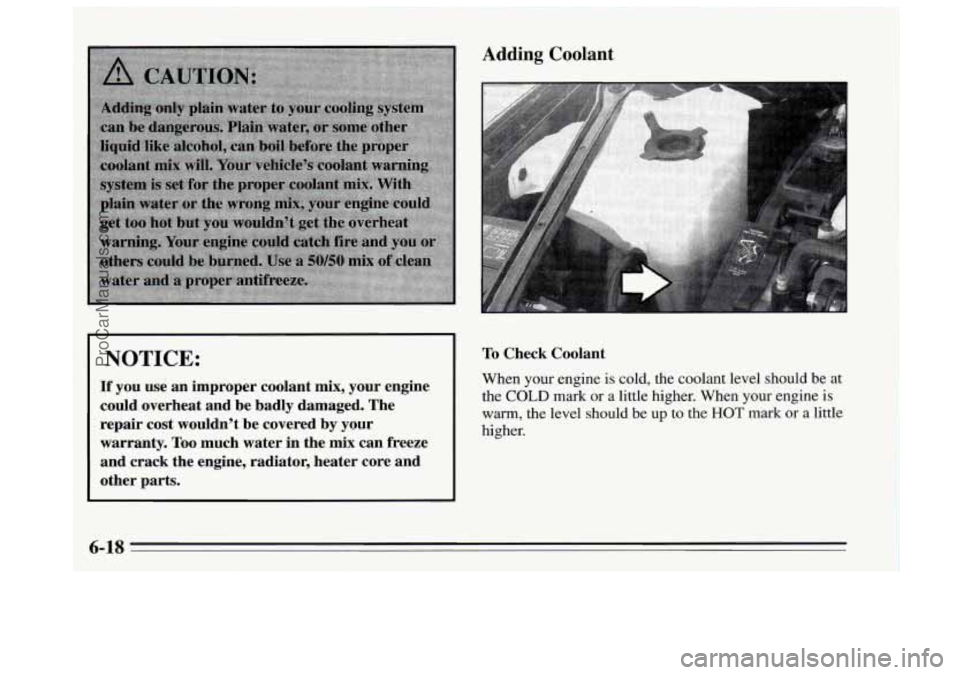
I NOTICE:
If you use an improper coolant mix, your engine
could overheat and be badly damaged. The
repair cost wouldn’t be covered by your
warranty. Too much water in the mix can freeze
and crack the engine, radiator, heater core and
other parts.
Adding Coolant
To Check Coolant
When your engine is cold, the coolant level should be at
the
COLD mark or a little higher. When your engine is
warm, the level should be up to the HOT mark or a little
higher.
ProCarManuals.com
Page 228 of 340
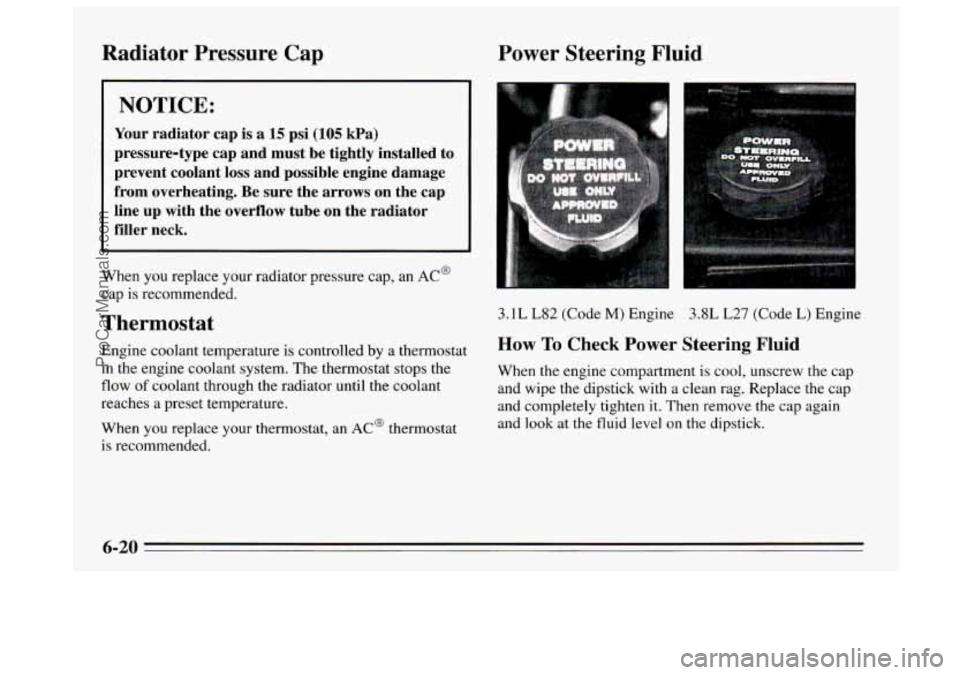
Radiator Pressure Cap Power Steering Fluid
NOTICE:
Your radiator cap is a 15 psi (105 kPa)
pressure-type cap and must be tightly installed to
prevent coolant loss and possible engine damage
from overheating. Be sure the arrows
on the cap
line up with the overflow tube on the radiator
filler neck.
When you replace your radiator pressure cap, an AC@
cap is recommended.
Thermostat
Engine coolant temperature is controlled by a thermostat
in the engine coolant system. The thermostat stops the
flow of coolant through the radiator until the coolant
reaches a preset temperature.
When you replace your thermostat, an
AC@ thermostat
is recommended. 3.1L
L82 (Code M) Engine
3.8L L27 (Code L) Engine
How To Check Power Steering Fluid
When the engine compartment is cool, unscrew the cap
and wipe the dipstick with a clean rag. Replace the cap
and completely tighten
it. Then remove the cap again
and look at the fluid level
on the dipstick.
6-20
ProCarManuals.com
Page 304 of 340
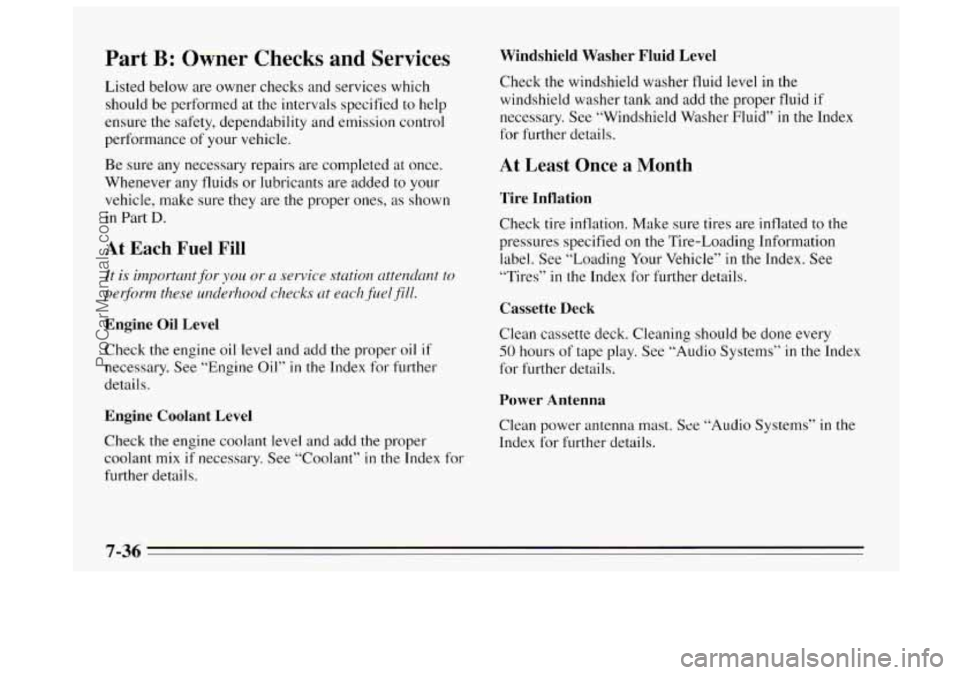
Part B: Owner Checks and Services
Listed below are owner checks and services which
should be performed at the intervals specified to help
ensure the safety, dependability and emission control
performance of your vehicle.
Be sure any necessary repairs are completed at once.
Whenever any fluids or lubricants are added to your
vehicle, make sure they are the proper ones, as shown
in Part D.
At Each Fuel Fill
It is inzportuntfor you or a service station attendant to
pecform these un,derlwocl clwcks at eaclz~fl~el~fi’ll.
Engine Oil Level
Check the engine oil level and add the proper oil if
necessary. See “Engine Oil” in the Index for further
details.
Engine Coolant Level
Check the engine coolant level and add the proper
coolant mix if necessary. See “Coolant”
in the Index for
further details.
Windshield Washer Fluid Level
Check the windshield washer fluid level in the
windshield washer tank and add the proper fluid if
necessary. See “Windshield Washer Fluid” in the Index
for further details.
At Least Once a Month
Tire Inflation
Check tire inflation. Make sure tires are inflated to the
pressures specified on the Tire-Loading Information
label. See “Loading Your Vehicle” in the Index. See
“Tires”
in the Index for further details.
Cassette Deck
Clean cassette deck. Cleaning should be done every
50 hours of tape play. See “Audio Systems” in the Index
for further details.
Power Antenna
Clean power antenna mast. See “Audio Systems” in the
Index for further details.
7-36
ProCarManuals.com
Page 331 of 340

Engine Coolant ................................. 6- 17
Adding
.................................... 6-18
Checking ................................... 6-18
Heater
................................ 2- 14. 6. I3
Temperature Gage
............................ 2-50
Temperature Light
........................... 2-49
Engineoil
..................................... 6-7
Additives
................................... 6-12
Checking
.................................... 6-8
What Kind to Use ............................ 6- IO
What to Do with Used Oil ..................... 6-13
When to Change
............................. 6- 12
Ethanol
(In Fuel) ................................ 6-3
Exhaust. Engine
................................ 2-23
Expectant Mothers. Use
of Safety Belts ............. 1-24
Extender. Safety Belt
............................ 1-50
Adding
..................................... 6-9
Fabric Cleaning
............................... 6-39
Fiberglass Springs
.............................. 6-44
Filling Your Tank ................................ 6-5
Filter
. Air Cleaner .............................. 6- 13
Finish Care .................................... 6-42
Finish Damage
................................. 6-43
First Gear. Automatic Transaxle
................... I 3-18
Fixed Mast Antenna ............................. 3- 19 Flashers
. Hazard Warning ......................... 5- I
Flat
Tire. Changing ............................. 5-24
Fluid Capacities
................................ 6-55
Fluid Levels. Maintenance
........................ 7-36
Fluids and Lubricants
............................ 7-40
Foreign Countries
. Fuel ........................... 6-4
Four-Way Manual Seat
........................... 1-2
Freeway Driving
............................... 4-18
French Language Manual
11
Fr011t Seatback Latches ........................... 1-5
Fuel .......................................... 6-3
Filling Your Tank
............................. 6-5
Gage
...................................... 2-44
In Foreign Countries
........................... 6-4
LowLight
.................................. 2-45
Fuse Block. Instrument Panel
..................... 6-48
Fuses and Circuit Breakers
....................... 6-47
.. ...........................
Gage . En. trine Coolant Temperature ............... 2-50
Gasoline
....................................... 6-3
Gasolines for Cleaner Air
......................... 6-4
GAWR
(Gross Axle Weight Rating) ................ 4-26
Gear Positions
................................. 2- IS
Glass. Cleaning ................................ 6-41
GloveBox ..................................... 2-8
GVWR (Gross Vehicle Weight Rating)
.............. 3-26
9-5
ProCarManuals.com